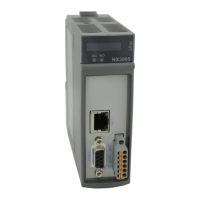6. REDUNDANCY WITH NX3030 CPU
6.4.15. Limitations on a Redundant PLC Programming
On a redundant PLC there are some limitations regarding its half-cluster programming. These limitations are treated in the
subsections below.
6.4.15.1. Limitations in Redundant GVLs and POUs
In a redundant GVL or a POU from the program type the following limitations must be respected for a correct functioning
of the half-clusters:
Do not use variables from the type VAR_TEMP
Do not mix variable types (VAR, VAR RETAIN, VAR PERSISTENT, etc...). Only one type must be used in each GVL
or POU
Do not mix symbolic variables declaration with ATs in the GVLs. Separate GVLs must be created where in one the AT
variables will be declared and in another, the symbolic variables
Do not store a variable address in a redundant variable (use a redundant variable as a pointer), as the variable addresses
may be different in the PLCA and PLCB
Do not use the function blocks for RTC reading and writing in redundant POUs. More details can be found on the section
RTC Clock
6.4.15.2. Non-redundant Program Limitations (NonSkippedPrg)
In a POU from the program type which aren’t redundant, the case of a NonSkippedPrg POU, the following limitations
must be respected for a correct functioning of the half-clusters:
The traditional function blocks TON and TOF can’t be used as they use the IEC timer. When the Stand-by PLC goes to
Active state (with the other half-cluster coming out of Active state), the IEC timer is synchronized, causing a discontinu-
ity in the timer value. The function blocks TON_NR and TOF_NR must be used instead, available in the NextoStandard
library. See Non-Redundant Timer
POUs from the program type written in the SFC language (Sequential Function Chart) must not be used, as they use the
IEC timer for transition timing
Do not mix symbolic variables declaration with ATs in the GVLs. Separate GVLs must be created where in one the AT
variables will be declared and in another, the symbolic variables
6.4.16. Getting the Redundancy State of a Half-Cluster
It is possible to verify the redundancy state of a half-cluster in the Redundancy Diagnostics Structure:
VAR
eRedStateLocal : REDUNDANCY_STATE;
END_VAR
eRedStateLocal := DG_NX4010.tRedundancy.RedDgnLoc.sGeneral_Diag.eRedState;
This way, the user can control a program logic that depends on redundancy state of the PLC.
6.4.17. Reading Non-Redundant Diagnostics
A redundant project, besides present redundant diagnostics ( Redundancy Diagnostics Structure or the diagnostics from
a PROFIBUS remote), presents also non-redundant diagnostics (diagnostics from the modules NX5000, NX5001, NX3030,
etc.). These non-redundant diagnostics could be invalid and must not be considered at the first instants in Active state, as they
aren’t synchronized with the other PLC (the diagnostic state when the remote PLC was active is unknown). Therefore, these
diagnostics must be ignored during the first moments in Active state, until they have valid values. Typically the time during
which the diagnostics should not be considered is 5 s.
The example below shows how to not consider the diagnostics bSlaveNotPresent and bPbusCommFail from the NX5000
PROFIBUS Master module.
Logic in NonSkippedPrg:
317

